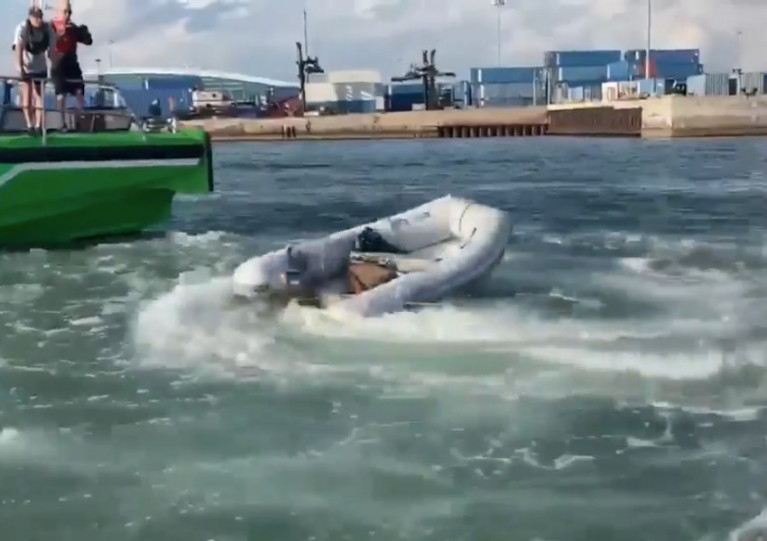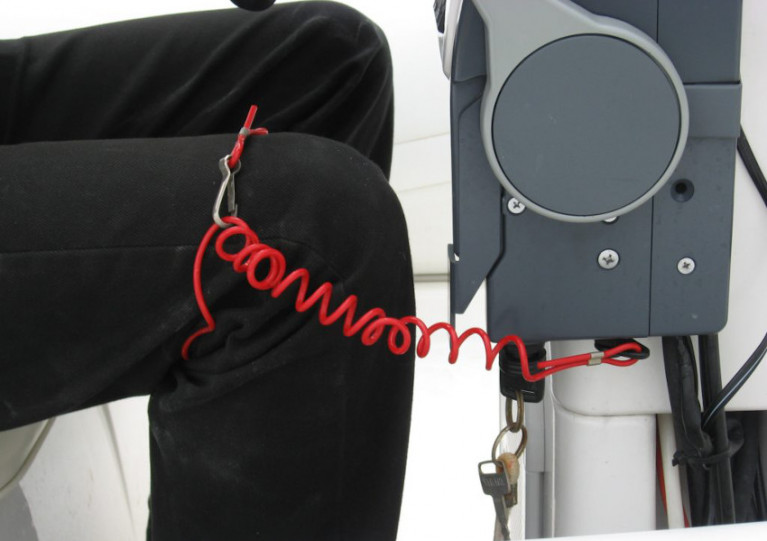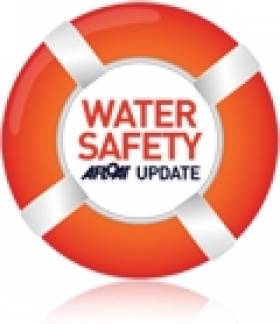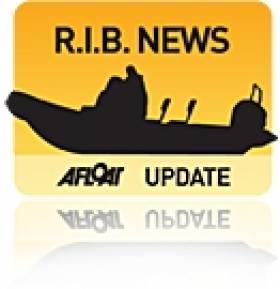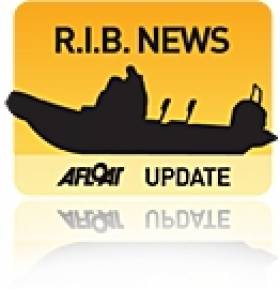Displaying items by tag: Kill Cord
US Boaters Reminded of New Kill Cord Law After Man Thrown From Runaway Boat in Miami
Marine Industry News reports on an incident in Florida recently where a man was thrown overboard from his motorised dinghy which then went out of control.
According to the Miami Herald, the incident last Monday (12 April) at Fisherman’s Channel off Miami saw the boat “spun furiously in circles, like an angry hornet doing donuts in the water” after its pilot was flung from the vessel and subsequently rescued by another boater.
Emergency responders managed to bring the runaway dinghy under control by tangling the prop of its outboard motor.
#Breaking #Watch @USCG, @MiamiDadeFire, #GoodSamaritan rescued 1 & stopped runaway boat near Fishermans Channel. The operator sustained minor injuries; declined medical assistance. New engine cut-off switch laws started April 1! Read more: https://t.co/HIsn43WWsA #BoatSafe #SAR pic.twitter.com/Lz2RkdkCEL
— USCGSoutheast (@USCGSoutheast) April 13, 2021
The incident comes less than three weeks after new legislation mandating the use of kill cords and engine cut-off switches on recreational vessels came into force in the United States, as previously reported on Afloat.ie.
New US Law Mandates Use of Kill Cords on Recreational Vessels
In the United States, all operators of recreational vessels under 26 feet in length will soon be required to use an engine cut-off switch and kill cord under newly passed legislation.
Kill cords are essentially safety tethers that cut power to a boat’s engine when its operator is displaced from the helm, whether by being thrown overboard or some other circumstance.
There are also now ‘wireless’ versions that use an electronic fob instead of a physical cord, and activate when submerged in water in a similar manner to an EPIRB.
According to the USA’s National Safe Boating Council, the new law — which comes into force on 1 April — was prompted by regular reports of boaters who fall or are unexpectedly thrown from their vessels which then run out of control.
“These dangerous runaway vessel situations put the ejected operator, other users of the waterway, and marine law enforcement officers and other first responders in serious danger,” it adds.
However, the US Coast Guard understands that the “overwhelming majority” of recreational vessels produced for decades have had an an engine cut-off switch installed “so this new use requirement simply obligates recreational vessel operators to use critical safety equipment already present on their boat”.
In the UK, the RYA already recommends the use of kill cords, and in Ireland they are also recommended in the Code of Practice for the Safe Operation of Recreational Craft.
Making A Better Kill Cord
#KillCord - Kill cords are an invaluable safety feature for both professional and leisure boat helms, but the system is far from perfect. It's easy to neglect to attach them, as was the case in last year's RIB tragedy in Cornwall, and sometimes they can malfunction, causing a boat to go out of control.
But there are a number of alternative solutions on the market that aim to make the use of kill cords as seamless as possible, as Motor Boat & Yachting reports.
The key to ease of use is wireless - a radio transmitter that you can wear as a clip or lanyard and never have to worry about it, as the engine is cut off automatically as soon as you're out of range.
Two wireless solutions are already available, however they are by no means foolproof, relying on batteries for power. MBY readers have already suggested a significant improvement, using RFID tags to make even smaller transmitters that don't need a power source, but even that comes with its own cons.
Motor Boat & Yachting has much more on the story HERE.
High-Speed Turn Led To Cornwall RIB Tragedy Says Official Report
#KillCord - An "exceptionally unusual" tight turn at high speed led to the death of a father and daughter and the serious injury of other family members in a tragic speedboat accident off Cornwall last year.
The Guardian reports on the conclusions of the official investigation into the incident on 5 May in which BSkyB executive Nick Milligan and his eight-year-old daughter Emily were struck and killed by the family's runaway RIB after being thrown overboard in the waters between Rock and Padstow.
It was previously found that the driver of the speedboat was not attached to the 'kill cord' that would have automatically shut off the engine. Instead, the boat continued to circle with its engine running, striking the family as they floated in the water.
Milligan's wife Victoria and four-year-old son Kit both sustained what were described by police as "life-changing injuries".
It has since emerged via the findings of the Maritime Accident Investigation Branch (MAIB) report that Victoria had been driving the boat in a slow wide turn when her husband reached across her to steer the boat hard to starboard at full speed.
The report added that "the manner in which Mr Milligan took the helm appears to have been out of character as he was known to be a safety conscious and prudent individual."
However, it was also found that the Milligans did not have a "good understanding" of how the speedboat would handle high-speed turns, nor were they aware of the hazards of their children being at the unstable front of the RIB.
The Guardian has much more on the story HERE.
#KillCord - An official report into the tragic speedboat accident in Cornwall earlier this month that killed a father and daughter says that the driver was not attached to the boat's 'kill cord'.
As previously reported on Afloat.ie, BSkyB executive Nick Milligan and his eight-year-old daughter Emily were struck by the family's runaway RIB after being thrown overboard from the vessel on the afternoon of Sunday 5 May.
Four other family members were struck by the runaway boat as it circled in the water off Padstow. Nick's wife Victoria and four-year-old son Kit are recovering after sustaining "life-changing" leg injuries.
Police were reportedly investigating the role played in the incident by the boat's kill cord or safety lanyard, a device attached to the throttle that should automatically cut engine power if the driver is thrown from the vessel.
Now The Guardian reports the Marine Accident Investigation Branch's (MAIB) conclusion that the 8m Cobra RIB was fitted with a kill cord, but it was not attached to the driver.
It has not yet been determined who was driving the speedboat at the time of the accident, nor is it clear how the family was thrown from the vessel.
The report added: "The kill cord serves only one purpose, to stop the engine when the driver moves away from the controls.
"To ensure that this tragic accident is not repeated it is essential that all owners and operators of vessels ensure they are fitted with kill cords."
Police Focus On Kill Cord In Cornwall RIB Tragedy
#KillCord - Police in Cornwall investigating the deaths of a father and daughter in a speedboat accident off Padstow at the weekend are focusing on the boat's 'kill cord', according to BBC News.
BSkyB executive Nick Milligan and his eight-year-old daughter were struck by the family's runaway Cobra RIB after losing control of the vessel and being thrown overboard.
Four other family members in the water struck by the 8m-long boat were hospitalised, with the BBC reporting that Milligan's wife Victoria and four-year-old son Kit suffered "serious, potentially life-changing injuries".
Witnesses describe the speedboat circling to hit the family after turning sharply and throwing them into the water, then continuing to run around in circles before it was stopped by local waterskiing instructor Charlie Toogood who jumped on board.
Investigators are looking closely at the kill cord or safety lanyard, a device attached to a boat's throttle that should automatically cut engine power if the boat's pilot goes overboard.
A malfunctioning kill cord was identified in an incident in Cork Harbour last summer in which a RIB pilot lost an arm after he was thrown overboard and subsequently struck by his runaway vessel, as previously reported on Afloat.ie.
Months before, an angler died and another was treated for hypothermia after being thrown overboard and separated from their vessel, a result of neither man using the kill cord on their boat's engine.
Man Lost Arm After Going Overboard from RIB In Cork Harbour
#MCIB - A man who lost his arm when he fell overboard from his boat in Cork Harbour last summer could have avoided the accident if he had followed essential safety precautions, according to the official report into the incident. The full report is available to download below as a PDF document.
Owen Corkery of Carrigaline was the subject of a 'miracle rescue' on 9 June 2012 when he was thrown overboard from his RIB, which subsequently struck him several times after he entered the water near Haulbowline Island, causing serious injuries to his head, back and left arm.
As previously reported on Afloat.ie, the RNLI said Corkery was "incredibly lucky to have been spotted from the shore" by a man now known to be Paul Bryans, who had been looking through a telescope at Fort Camden in Crosshaven approximately a mile away from the site of the incident.
Bryans and colleague Dick Gibson immediately raised the alarm with the emergency services and Crosshaven RNLI respectively, and rescue crews were dispatched within minutes.
While the lifeboat volunteers took control of the wayward RIB, Corkery was quickly retrieved from the water by the crew of the Cork Harbour Pilot boat Sonia. They found him incoherent and bleeding heavily, and also noted that while he was wearing a working personal flotation device (PFD), he was not wearing warm clothes or shoes.
Corkery was transferred via ambulance to Cork University Hospital, where his left arm was later amputated just above the elbow due to the severity of his injuries.
According to the official report into the incident by the Marine Casualty Investigation Board (MCIB), the RIB was found to be undamaged but had no CE or other approval mark.
The kill cord on the boat's motor was also found to be malfunctioning, as the engine could be started whether or not it was attached, and did not shut off when removed.
The report states that Corkery - an experienced powerboat user who had not completed any recognised handling course - has since explained he was aware of the kill cord malfunction but continued to use the vessel.
He confirmed in the same interview with investigators that he was standing beside the helm of the RIB at the time of the incident, a position that "would have made him considerably more likely to be thrown from the vessel".
Investigators also found it likely that Corkery's lack of shoes would also have reduced his grip while standing on the floor of the RIB.
In its conclusions, the MCIB report - which is available to download below - emphasises that the kill cord is an "essential part of safety equipment for all open motorboats" that should always be used and checked regularly, and that the helm of any high-speed watercraft should always remain seated, even at low speeds.
It also recommends that all pleasure craft owners should complete a recognised powerboat handling course.



























